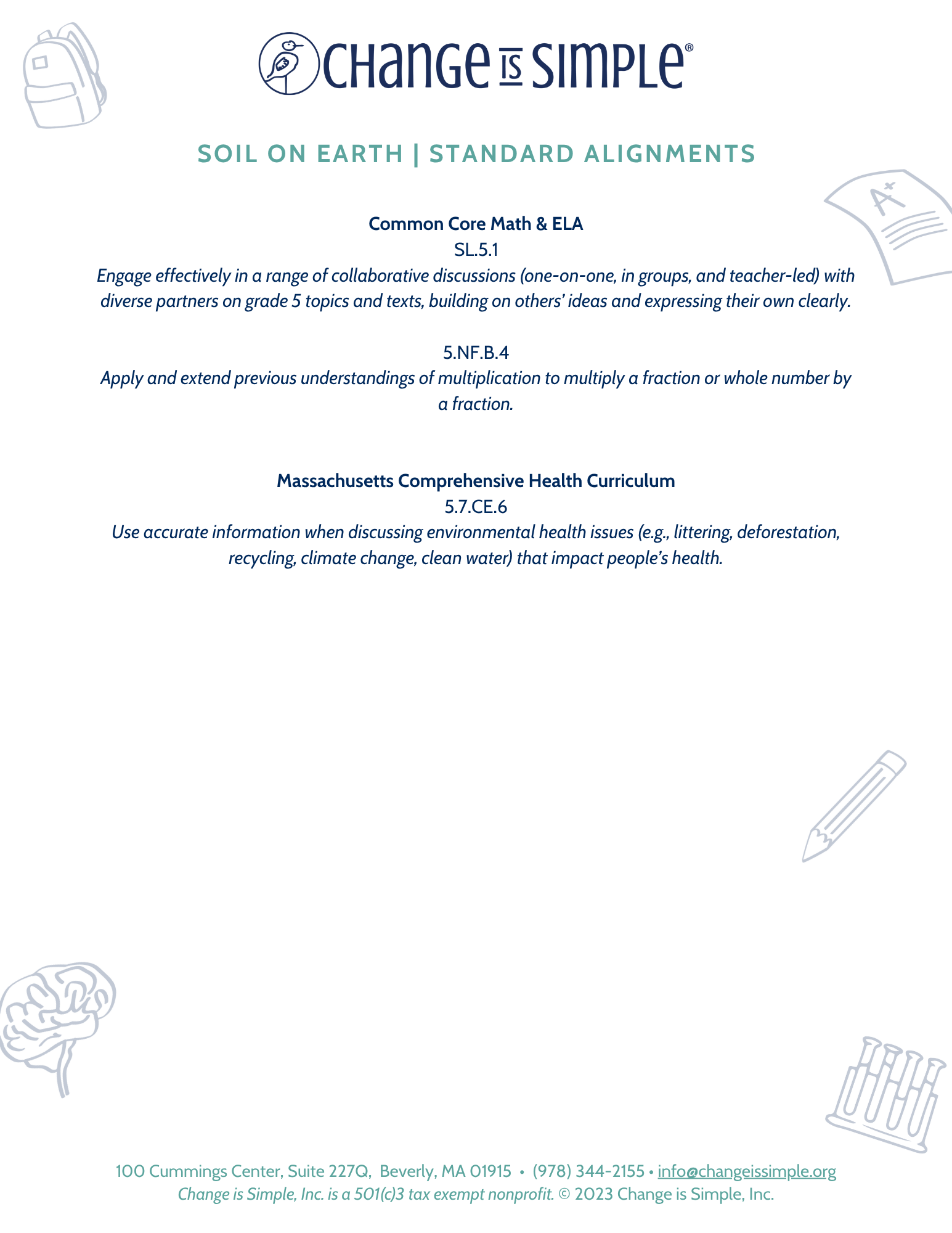soil on earth
Essential Questions:
How does soil contribute to the production of food?
What fraction of Earth's surface is suitable for food production?
What role do worms play in the process of creating nutrient-rich soil?
Lesson Objectives:
At the end of the workshop, students will be able to:
Explain why soil is one of the most important natural resources
Identify reasons why soil health and availability is in decline
Explain how worms contribute to health soils
Explore our resources
Click on the images to access each resource (available as a PDF or webpage)
Take-Home Guide
Information for parents & legal guardians (available in English and Spanish).
Información para padres de familia y tutores legales (disponible en Inglés y Español).
Standards Alignments
Explore the ways our program aligns with CCSS + NGSS standards.
Vocabulary
Quiz your students on vocabulary used during our lesson!
Compost Bottle Activity
Students create compost bottles using recycled materials.
Social Emotional Learning Activity
Students write and reflect on the mini documentary “Unbroken Ground”.
Soil Sampling Activity
Students take soil samples from around their school.
Infographic
Learn about all of the life that soil supports!
Video Resources
Explore relevant video resources.
Reading Resources
Explore relevant reading resources.
Challenge Print-Out
Print out the challenge for your students to complete!
Challenge Guide
Completing this challenge will help your school become a CiS Certified Sustainable School!
Lesson Reflection
Print and send home this reflection activity to show families what their student learned.
Background Information
Soil is the medium in which 95% of the food we eat relies on either directly or indirectly, making it an invaluable natural resource. Currently only about 3.5% of Earth's surface has soil rich enough for food to grow in. This number is slowly decreasing annually though due to erosion and urban development. Soil erosion increases when there is not enough vegetation in the ground to hold the soil in place, and the soil is left exposed to water and wind. The loose soil is swept away by runoff and has led to increased pollution and sedimentation in streams and rivers. This then results in clogged waterways and causes declines in fish populations.
There are different types of soil erosion: natural and anthropogenic. Natural soil erosion occurs from water and wind slowly remove soil on the edge of water sources. This damage comes from things like hurricanes, and storm surges. Anthropogenic soil erosion happens much more rapidly. Deforestation and overgrazing of farm animals are two of the many anthropogenic sources of erosion. Also, as anthropogenic climate change continues to increase, extreme weather events become more severe, and happen more frequently. This makes recovering after a damaging weather event much more difficult, and weakens their ability to survive the next one.
What Can We Do to Help?
To combat soil loss, composting is one of the best ways to help make new soil! Composting speeds up the decomposition of old food and turns it into new healthy soil. Organic waste from our food scraps typically ends up in landfills and incinerators, which produces high levels of methane, a harmful greenhouse gas. The more food waste we divert from landfills and incinerators, the better! An essential part of composting is the aid of worms! Worms speed up the production of new nutrient rich soil by eating the food scraps, brown paper, and plant trimmings that are put in the compost and turn it into soil. When digested, the castings worms produce contain plant nutrients such as nitrogen, calcium, magnesium, and phosphorus that might otherwise be unavailable to plants. It takes, on average, two to six months for food and plants to decompose in a compost bin.
Decrease Food Waste!
1/3 of all food grown across the world is wasted. That amounts to about 1.3 trillion tons of food wasted every year, which generates about 3.3 billion tons of carbon dioxide. If food waste was a country it would be the third largest producer or carbon dioxide. Redirecting food waste into compost reduces the effects of climate change and increases soil availability for food production.












